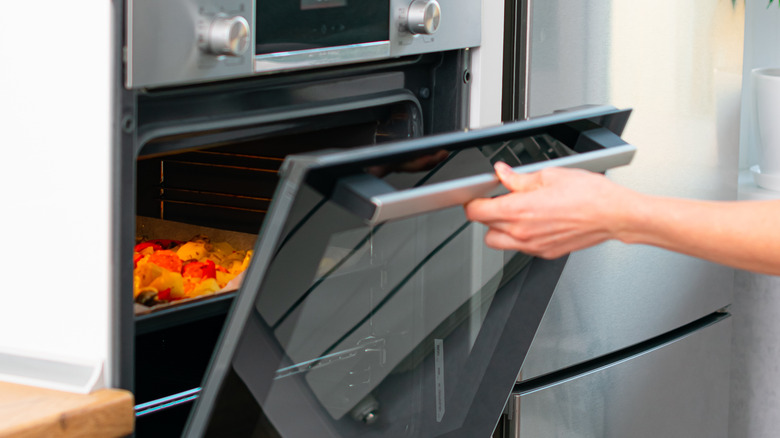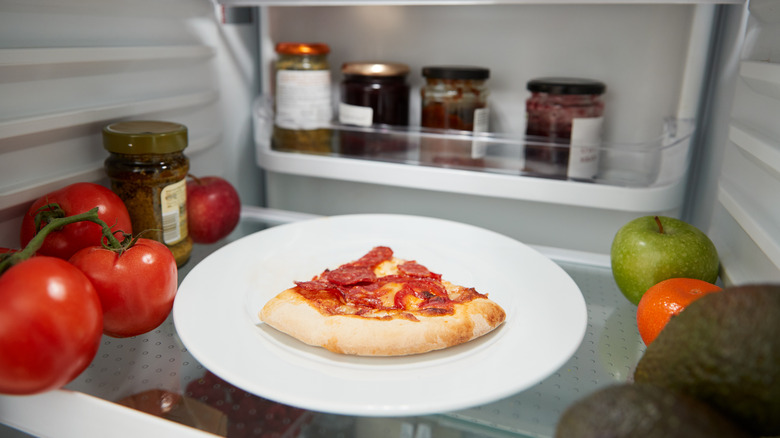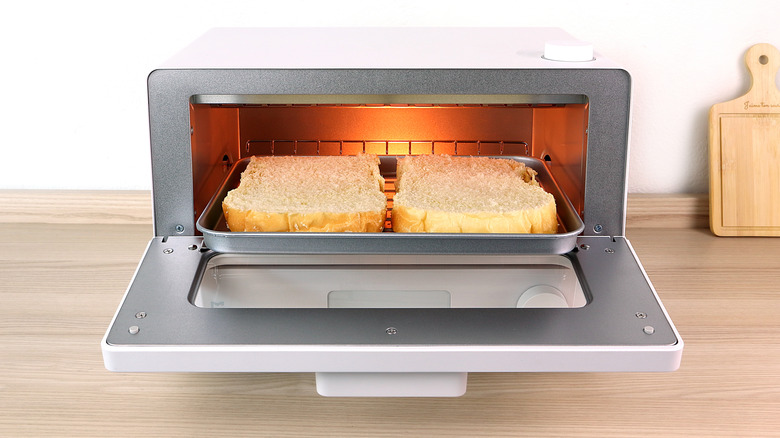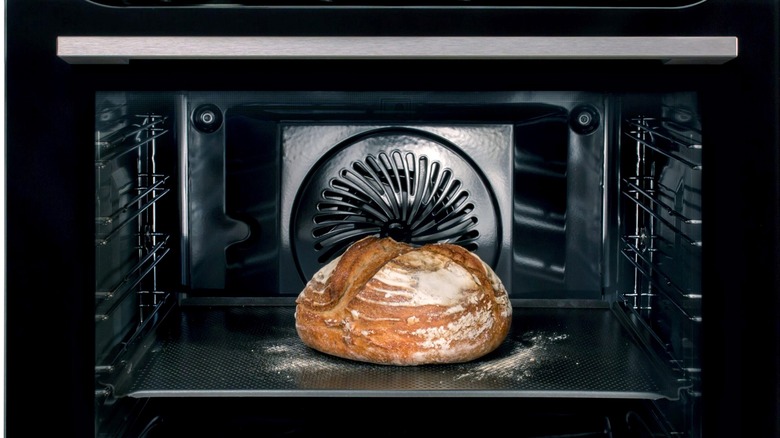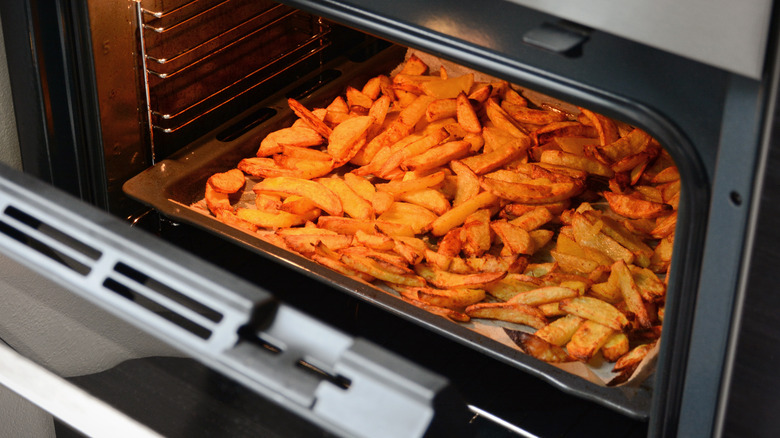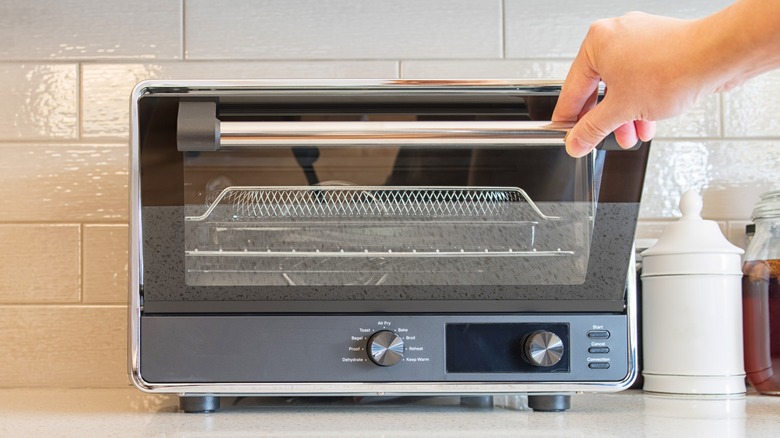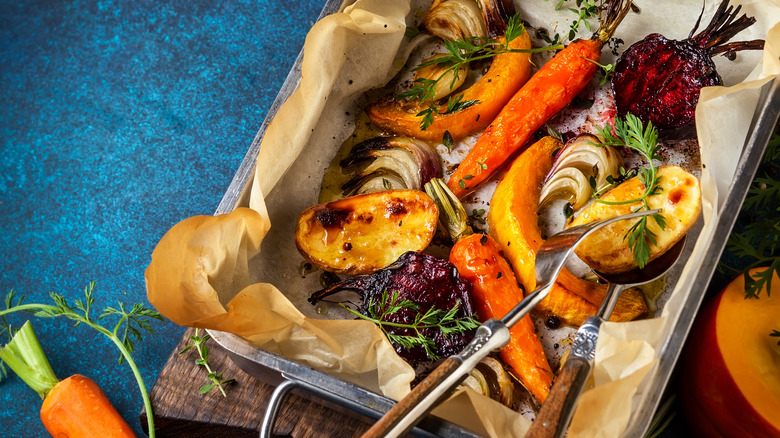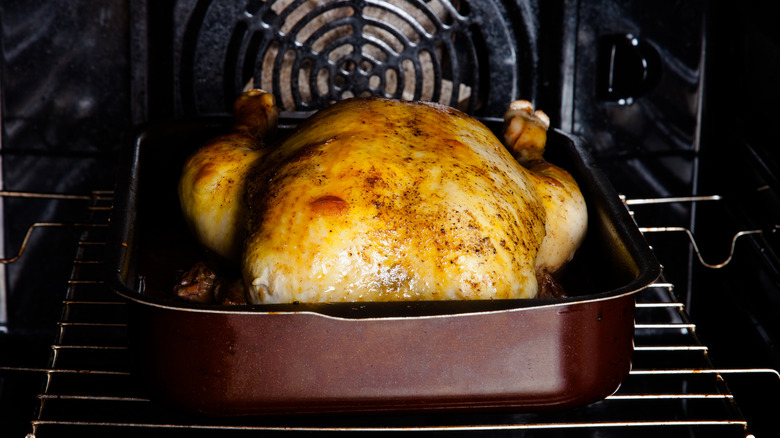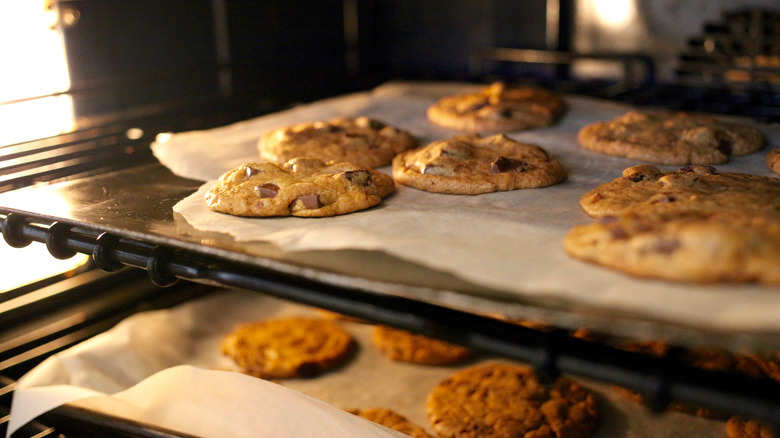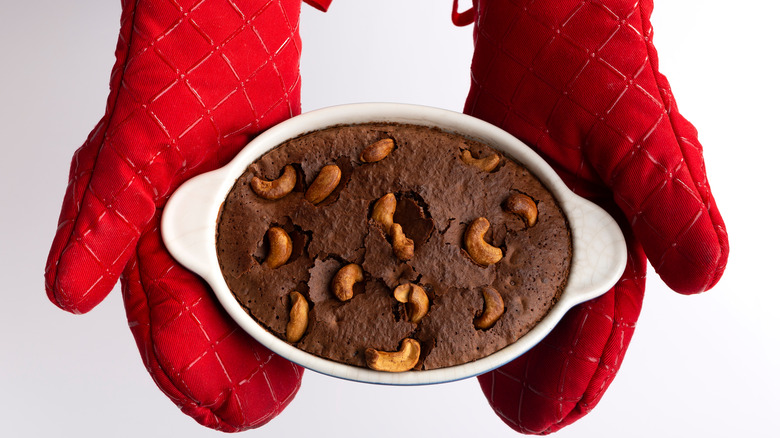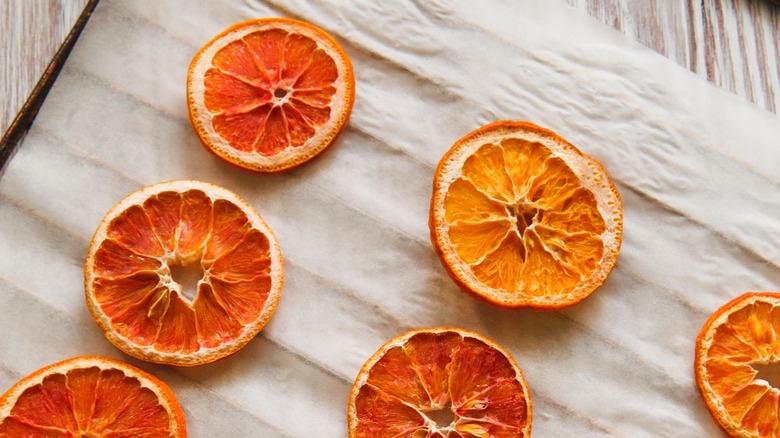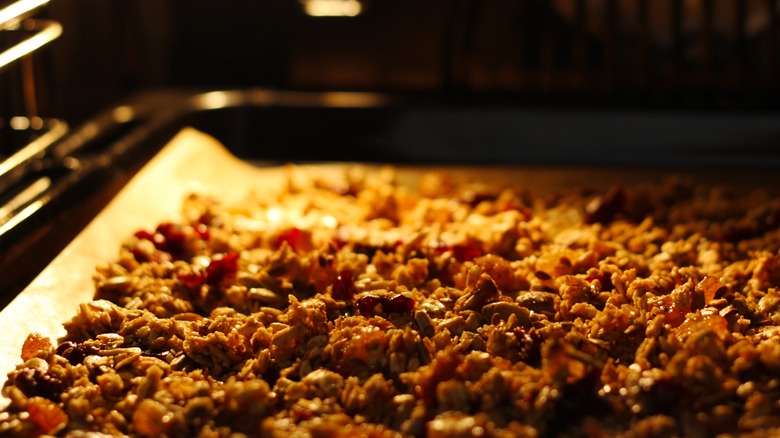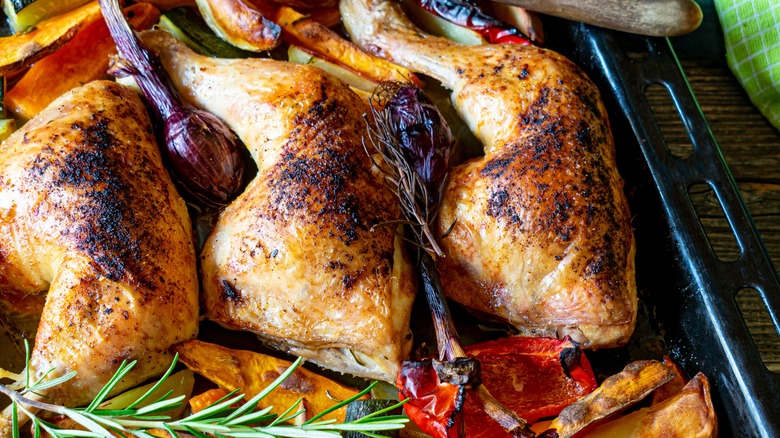The Absolute Best Ways To Use Your Convection Oven
Convection ovens come in all shapes and sizes. From countertop appliances that double as toaster ovens, to full-sized ovens, there's an option for everyone's kitchen. But how is a convection oven different from a conventional oven? And is one better than the other?
Unlike a conventional oven that cooks food from the bottom or top with a direct heat source, convection ovens use fans and an exhaust system to move hot air throughout the oven, cooking food all over and around while also wicking moisture away. This means food is cooked quicker and more evenly than in a typical oven, as well as crispier (think about the chicken skin!).
Ultimately, some recipes are tastier when they're made in a convection oven. Does this mean convection ovens are better than traditional ones? Not necessarily. It just depends on your preferences and what you're cooking. Whether you have a convection oven, or are thinking of purchasing one, take a look at our list of the best things — from recipes to kitchen tips — you can do with them.
Reheat leftovers
If you were raised in a house without a microwave, then you're almost definitely familiar with a countertop convection oven for a major reason: heating up leftovers. They are the perfect size for warming the Indian food or pizza slices you couldn't finish off last night. If your oven came with a small tray, this is the perfect time to use it. Simply line the bottom with aluminum foil, empty your Tupperware, and press the start button. Some ovens include a basic convection setting, while others include a number of specific settings perfect for warming up food. Depending on your model, you could have an option for baking, reheating, and even the very explicit "pizza."
A convection oven is especially great for reheating food because of the fan, which cooks food all over and around, rather than simply radiating from above or below. This is why even if you do have a microwave, sometimes a convection oven is a better option — no more digging into your leftovers and finding a cold center!
Toast bread
Any foodie worth their salt will tell you to skip the toaster and either pan-fry your bread in olive oil or use the bake setting on your oven to achieve the perfect piece of toast. But this tip is less about gate-keeping toast, and more about understanding which model of a convection oven you have.
Most countertop convection ovens have become synonymous with a toaster oven (the main difference between a toaster and convection oven is heat distribution). If you have the latter, simply select the "toast" option on your machine and use it like any regular toaster. If you have a convection oven — either the real deal or a countertop version — then you can choose between broiling your bread or setting the oven to 325 F (via Hunker). Simply wait until you reach the ideal toastiness.
Beyond the quality of your toast, convection ovens are superior because of how easy they are to keep clean. All the bits and pieces that come with your toast will stay on the tray. No more crumbs falling into the pit of your toaster and staying there forever, getting increasingly more burnt.
Revitalize stale bread
We've all been there: You excitedly purchased a farmer's market loaf of bread but it practically went stale overnight. Often, you'll see people make homemade croutons out of this. But if you've got more croutons than you know what to do with, or you're not ready to give up on that loaf, you can use your convection oven to revitalize it.
To bring stale bread back to life, run the loaf under water until it is completely soaked (via Food Network). You want to aim the cut side away from the faucet so only the crust gets moistened. But if you do end up getting the inside of the bread wet, this trick will still work out fine. Next, stick the soaked loaf into a convection oven set to 300 F for 6 to 7 minutes, or longer depending on how drenched or large the loaf is. When you open the oven door, you'll find good-as-new bread that you can slather with salty butter and bright jellies.
Crisp up french fries
You will get tired of hearing this over and over but it's the most important thing about convection ovens: They have fans that circulate hot air all over and around your food. So when it comes to french fries, especially if you prefer them crispy, convection ovens are the perfect kitchen appliance.
If your ideal french fry is soft in some places, crispy in others, then you may not like using a convection oven. (But you would also be wrong.) To reach that ideal crunch of a satisfying fry, you need an even distribution of heat. When it comes to taking your frozen french fries to the next level, we recommend placing a wire cooling rack inside your baking tray to bring your fries crunch to the next level each time. But even for fries made from scratch, the convection oven is ideal for all the same reasons. You can go as simple as olive oil and sea salt, or get fancy with additional flavors and spice mixes.
Prepare side dishes
The magic of a countertop convection oven really lies in providing any multi-tasker the perfect kitchen side-kick. Perhaps a simple reason to love them, but if you ever find yourself cooking Thanksgiving dinner or hosting 10 or more people, you'll be glad to have another device in your repertoire.
Because of their compact size, countertop convection ovens are ideal for preparing side dishes. Use your traditional oven for the big stuff — like a pot roast or a crowd-pleasing lasagna — and the convection oven for accompaniments like asparagus, roasted veggies, or crispy potatoes. With the convection oven being a separate appliance, you can save space in your traditional oven and easily manage dishes with a shorter cook time.
If you do happen to mess up the math and have one part of the meal ready long before the other, simply switch the convection oven to "keep warm" and make sure the dish remains happy until dinner is ready.
Roast veggies
When it comes to perfectly roasting veggies, if you don't have a convection oven in your home, you're already at a disadvantage. This is because convection ovens blow around hot air that evenly cooks your vegetables and does away with moisture which would otherwise render them soggy. In the end, you'll be left with perfectly roasted vegetables with crisp edges (which are always the best part).
If they still come out a bit one-dimensional, we recommend adding a secret ingredient to your vegetables for an extra kick. Simply prepare your carrots, Brussel sprouts, or zucchini like normal — a drizzle of olive oil, salt, pepper — but before placing them in your oven, give your veggies a dash or two of your favorite vinegar. Balsamic works great, as does apple cider. But if you want to get even fancier, try any one of the specialty mixes from Acid League for more contemporary flavors. The bite of vinegar combined with a convection oven roasted veg that is perfectly crisp is just unbeatable.
Roast chicken
When it comes to roasted chicken, there are a few absolutes: Your chicken must have crispy skin, be golden brown in color, and moist inside. So it makes perfect sense that cooking a whole bird provides a great opportunity to use a convection oven to your advantage. Why? Because the convection oven's fan helps cook the chicken all over, rather than over-cooking the top or bottom, which often happens in conventional ovens. And we all know there's nothing worse than one part of the chicken being perfectly cooked while the rest is still raw. By the time everything is cooked through, you'll end up with dry white meat.
This will result in crispy skin all over the bird and a moist, evenly-cooked interior each time. You can, of course, adjust a traditional oven's settings to get close to operating like a convection oven, but it will never be the same. Once you roast a full chicken in a convection oven, it will be impossible to prepare it any other way.
Bake cookies
It can seem like convection ovens were exclusively made for cookies. While the fan and exhaust system don't work with more delicate desserts like cakes, cookies love the circulation of hot air and lack of moisture you get in convection ovens (via eHow). However, you will want to use a flat baking sheet. Trays with taller sides will stop the hot air from getting all around the surface of the cookie and result in uneven baking. Also, if you haven't baked cookies in a convection oven before, just make sure you keep an eye on them. Convection ovens tend to work faster than a conventional one — which when it comes to cookies, is a major plus.
Given the even distribution of hot air and lack of moisture, your cookies are likely to come out a bit on the crunchier side. If you prefer a gooey, barely-cooked cookie, just make sure to watch the oven and keep an eye out for that quicker baking time! In all, you want to annex your cookie recipe's baking time, and figure it out on your own.
Make a dessert for one
You don't have prepare desserts in bulk. Convection ovens — especially countertop convection ovens — are great for baking single-serving sweets. Typically recipes for individual desserts call for a microwave. Take the simple-to-make mug cake, for example. People love that they can satisfy their late-night hankering for something sweet by running downstairs, throwing some ingredients into their favorite coffee mug, and microwaving for a few seconds to enjoy a freshly-made dessert.
But if you're looking for something with more of a traditional cake texture, or want to expand your desserts-for-one possibilities outside of cake, then a countertop convection oven is the perfect option. Again, its compact size means you can have all the benefits of a traditional oven, without the hassle or commitment. Plus, you can expect a more evenly baked product or crispier pie crust (via Food Network).
The possibilities here are endless! If you only have one banana left that's overly ripened, you can quickly throw some ingredients together and make a banana bread for one (we know this from personal experience). Or consider single-serve brownies, chocolate chip cookies, sweet breads, and more.
Dry orange slices
Around the holiday season, dried orange slices are especially popular (via Homestead and Chill). Simply scroll through Pinterest or Instagram, and you'll be met with stunning photos of orange peel garlands strewn across trees, banisters, or off chandeliers. However, making them is a bit of a long-haul.
To make dried orange peels, you will want to slice your fruit thinly, place them in a single layer on a baking tray, and bake them at a very low temperature for hours. Having a convection oven — whether countertop or not — is a huge plus here. Given its fan that circulates air all around your food, you can expect a much more even finished product, which is incredibly important when it comes to drying foods so that nothing goes rancid over time. You should also expect the oranges to dry faster than in a conventional oven thanks, of course, to the circulating fan.
If these are more for snacking than decoration, consider dipping the slices in dark chocolate for a satisfying treat. Or use them to top chocolate mousse!
Bake homemade granola
Granola is the perfect topping to our morning yogurt, is always there when we're rushing out the door, and is packed with nutrients and fiber. But if store-bought bags are eating into your budget, consider preparing a batch from scratch. It is surprisingly easy to make homemade granola, and it's totally customizable.
No matter what recipe you use, it is as simple as throwing a bunch of ingredients together in a bowl and baking them in a single layer. Using a convection oven is perfect for this as it will reach inside all those nooks and crannies in your oats, nuts, and fruits for a uniform granola that is crisped throughout. This is especially important if you're making a large batch that you plan on storing. A countertop convection oven, on the other hand, is ideal if you want to make granola for one — or realize too late that you're out and need a quick fix. Simply quarter or half your favorite recipe.
Tackle a sheet pan dinner
The ultimate weeknight meal, a sheet pan dinner is a prime candidate for your convection oven. Like with the cookies, you'll want to use a tray with a small lip or none at all so that the hot air can properly circulate around your ingredients. Your options are seemingly endless. You can prepare a sheet pan spatchcocked chicken recipe or just stick with breasts, thighs, or drumsticks. Or, if you're in the mood for seafood, try a maple-glazed salmon sheet pan recipe. Simply nestle your fish in between potatoes, carrots, and about-to-be charred onions — it doesn't get much simpler.
Sheet pan dinners are heralded because of this — everything in one place, only one dish to clean up at night's end. And when you use a convection oven, countertop or not, you can set it, forget it, and still end up with a myriad of textures.
